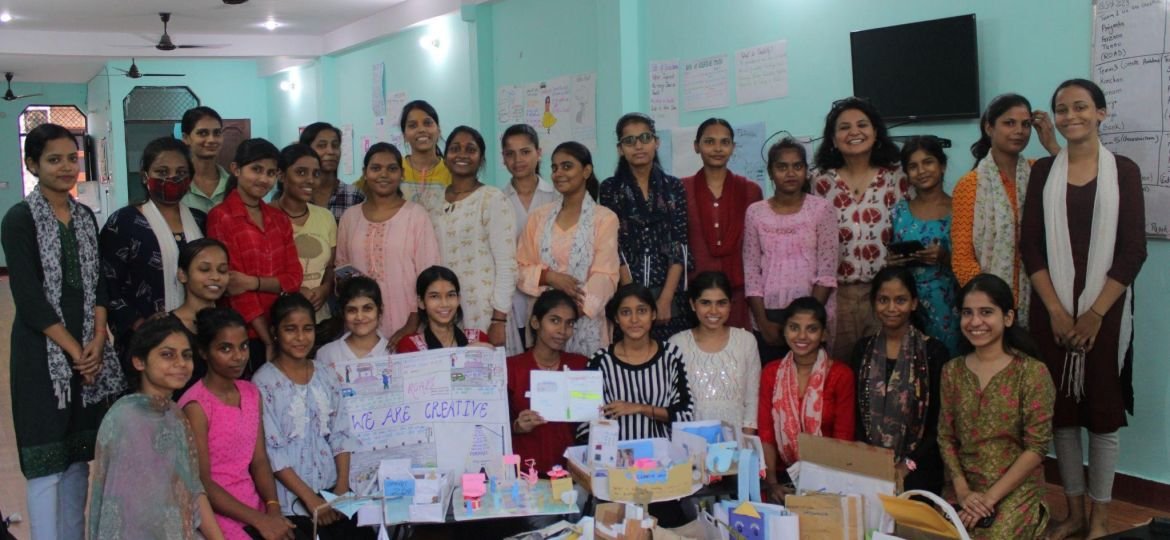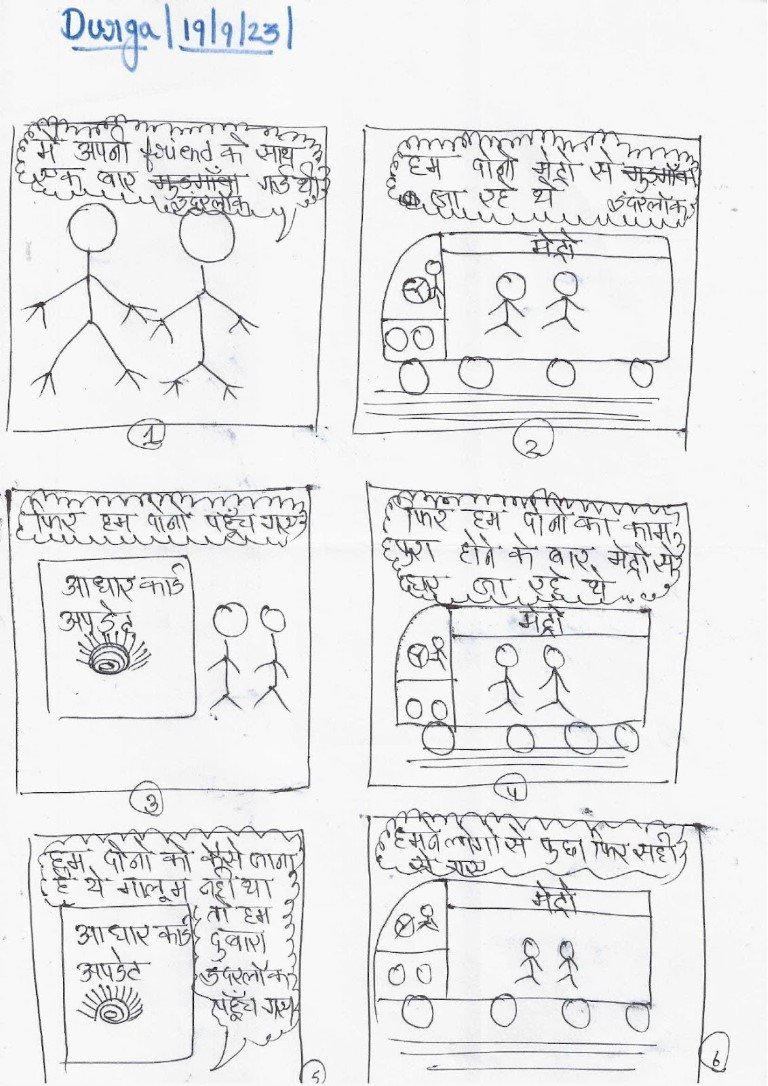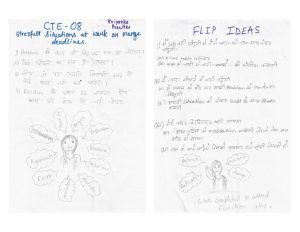
Author: Butool Abbas
Select all the things that require creativity
- A wall hanging
- Thinking of solutions to get out of a room without windows
- Meeting a deadline effectively along with managing a work-at-home
- Making a room full of people laugh
- Making Teaching tools
- Making an excuse for not completing homework
- A clay sculpture
- Making a comic on an incident of your life
- Thinking of unusual ways to use a plastic bottle
- Making an Instagram reel
- An engaging conversation
- Thinking of ways to get out of a muddle at work or life
If we ponder a bit, we all would realize the answer is ALL OF THE ABOVE
Still, the way we look at creativity today is very unidimensional; restricting it to things that bring delight to our senses as fully formed artifacts. However, the act of being creative itself can run deeper than just the apparent beauty that emerges from it.
For communities forced to choose resilience as a way of life, it can help channel some of the very virtues that they had to build as survival skills to now enhance and liberate themselves. Being comfortable with chaos, being resilient, acceptance of failure are some of them.
Sustained creativity as a way of life requires creative confidence. It’s a mindset of having faith in one’s creative abilities and being willing to take risks in expressing and applying those ideas.
Program Structure and Approach:
 When Thinkizm was invited to create a Creative Confidence journey program for the Protsahan fellowship Cohort 2023, the aim was clear; consistent effort to bridge gaps in relevant workplace skills that can be built while developing mindsets needed for Creative confidence. As creativity takes its own time to blossom and requires nurturing, a 3- month long module was built.
When Thinkizm was invited to create a Creative Confidence journey program for the Protsahan fellowship Cohort 2023, the aim was clear; consistent effort to bridge gaps in relevant workplace skills that can be built while developing mindsets needed for Creative confidence. As creativity takes its own time to blossom and requires nurturing, a 3- month long module was built.
The program comprised 2 immersive half-a-week workshops, multiple online sessions, and offline activities. Each component was meticulously designed to foster creativity, with a focus on mindset shifts and practical application. Participants were introduced to various methodologies, such as brainstorming and assumption reversal techniques, to stimulate creative thinking. In the end, tying it up with teaching a framework to solve open-ended problems, and design thinking.
Shifting mindsets
In a world fixated on conformity and seeking approval, true creativity means being open to new ideas and ways of thinking. It’s not just about learning techniques; it’s about shifting our mindset.
Multiple fun activities were aimed to stretch the boundaries of the minds of the young learners. For instance, the ideator mindset activities focused on generating multiple ideas and finding solutions within constraints.
Activities designed to foster empathy helped to understand different perspectives and collaborate across cultures.
The maker’s mindset encouraged us to experiment and embrace failure as a part of the learning process. And finally, the explorer’s mindset activities encouraged curiosity and questioning assumptions.
We engaged in activities like What scenarios, Creating Comic books, unusual uses of daily objects, Real-life scenarios, and assumption reversal to solve, Design thinking challenges like How to create a thriving and safe city for women ( looking at various spaces like parks, entertainment places, public transports etc), Redesigning a Handbag.At the end of it, the fellows had created numerous sketches of new ideas, prototypes, comic panels, presentations solving real-life situations, etc.



 The Two-way Learning Process: My Reflections
The Two-way Learning Process: My Reflections
We kickstarted our first 3-day workshop in July. And it turned out to be one of the toughest weeks to feel creative, as the Delhi floods had just occurred. Delhi’s humidity and overall chaos were at its height. While I was anticipating challenges to establish an optimal learning environment, I was met with happy gleaming faces, bursting with curiosity and eagerness to embark on this creative journey! This indeed made my task easier.
One of the common areas of struggle was finding ways to generate more than one idea and resistance to visualizing ideas on paper.
Most fellows showed a sense of overwhelm to the lack of structure ( whether in open ended nature of activities, or deliberate lack of overdefined instructions ) initially. This feeling persisted till the end of the workshop but the sense of overwhelm was slightly lesser.
What was seemingly novel for the girls was also the idea of time restriction for every activity. Time constraints have been proven to help in building the ability to think divergently.
Over time, their perception of their own creativity seemingly changed, and were ready to pick up open-ended fuzzy problems as opposed to overwhelm at the beginning of the 1st module. Some testimonials can help us understand this.
From being reluctant and apprehensive to push their boundaries of thinking initially, many fellows showed a change in attitude around divergent thinking. They were able to generate multiple ideas( 2-3) for a given problem.
For me, the biggest takeaway was how the lens of kindness was used to give feedback to their peers. They were encouraging of their fellows.
 Impact:
Impact:
To understand the impact, we focussed on measuring the Creative potential via some established methods of testing creativity in the beginning and then using the same tests at the end of the module.
During our three-month program, we noticed some interesting changes in how our fellows approached creativity
At the start, only about 30% of them could draw more than 15 objects in 10 minutes during the “20 Circles” activity. But by the end, almost 80% could do it, showing a big improvement.
In another activity where they had to think of unusual uses for objects like plastic bottles, only 33% of them could come up with more than 5 ideas at first. But later on, 100% were able to think of more than 10 ideas each. This shows they became much more creative and flexible in their thinking over time.

Some Verbatims of the Learning Experience by Participants
“मैने किसी भी प्रॉब्लम को देखना, सोचना, और समझना, फिर उसपर काम करना समझा”
“मुझे यह भी एक और सीख मिली कि पहले डायरेक्टली प्रोब्लेम्स का सलूशन न निकालकर हमें उसे पहले देखना, समझना है”
“मुझे यह सेशन अच्छा लगा – जो भी हमने प्रॉब्लम सॉल्व करी बाहर जाके, उसमे पहला तोह मेरा कॉन्फिडेंस बढ़ा और मुझे उन बड़ी प्रोब्लेम्स की सलूशन ढूंढने के ज़रिये छोटी प्रॉब्लम को जल्दी सॉल्व करना आया।”’
“प्रोफेशनल लाइफ में हमारे लिए बहुत हेल्पफुल हो सकता है क्रिएटिव तरीके से अपनी बात रखना, कुछ क्रिएटिव प्लान करना”
“ड्राइंग के माध्यम से लोगों को समझा सकती हूँ अपनी प्रेजेंटेशन को”
“जब हमने कॉमिक स्ट्रिप वाली एक्टिविटी की, तब उसमे अपनी बातों को कार्टून और ड्राइंग के ज़रिये बताना बहुत अच्छा लगा।”
“जब हमने मॉडल्स बनाये, सलूशन जान्ने के बाद एक तोह क्रिएटिविटी बढ़ी हमारी और जब साथ मिल कर आइडियाज सोच रहे तोह हम एक दूसरे को भी बहतर समझे!”
Parting Thoughts
As I worked with these bright resilient faces working to make a future for themselves, I realised that there is more than meets the eye when it comes to learning creativity. Creativity is more empowering than it is credited to be. Summarising some of my thoughts
To be creative is an act of rebellion against the norm, the accepted.
Creativity stems from a want to let your unique voice be heard.
To ponder solutions is to allow one to create possibilities and then make choices.
To be creative is to hone a sense of agency in oneself.

